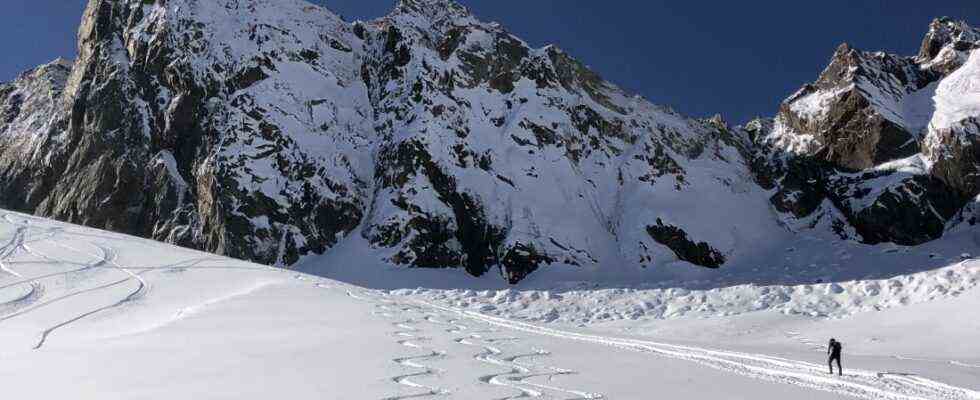The Tyrolean tourism industry may now even have the weather on their payroll – or the Stubai Glacier ski area is simply incredibly lucky: Right on time for the kick-off weekend, the first since the introduction of the Covid vaccination, the sky is even banking on extensive relaxation. Down in the valley there are still a few last wisps of fog, above 2000 meters 40 centimeters of fresh snow whitewash the mountains in a white that harmonizes with the clear blue autumn sky above.
So there are the best conditions to lure Austria’s most important group of guests, almost weaned from pisteln (vulgo: the Deitschn), back into the valleys, which have been weaned by German skiers for almost as long. After all, it has been an eternity – with minor exceptions – a year and a half ago that winter sports enthusiasts in this country were allowed to pursue their hobby with the usual limitlessness: in spring 2020 first the Ischgl fiasco with the abrupt end of the ski season, then the quasi-tourism lock in winter Austria including travel requirements and the standstill of the lifts in many other countries, including Germany. Anyone who wanted to go abroad – for example to Switzerland or Austria – had to either be quarantined afterwards or violate the Covid requirements. And skiing wasn’t that important to most of them.
A little later than usual, the Stubai Glacier, one of the most important autumn ski areas, especially for Bavarian ski enthusiasts, opened last weekend, as did the ski area on the Kitzsteinhorn; the Mölltaler Glacier follows on October 14th. Other glacier ski areas such as in Sölden or in the rear Pitztal have been in operation for weeks, the year-round Hintertux Glacier has announced 40 kilometers of groomed slopes for the next few days.
There is still room for improvement on the crucial Piefke scale
And what are the potential guests doing? Despite the withdrawal, they are apparently not really in the skiing mood or have got used to a life without snow faster than the ski industry would like. Or maybe they just wait until more than four lifts and a few kilometers of slopes are available. During the journey through the Stubai Valley, it quickly becomes clear that the crowd at the Eisgratbahn valley station that caused a (social) media turmoil exactly a year ago in view of the increasing incidence is not to be expected, at least not yet. If only because the Eisgratbahn is not yet in operation.
At 9.15 am, the lady at the cash register, who doesn’t seem overwhelmed, says: “Hopefully there will be more soon,” and says the guests. Minutes later you sit all alone in the feeder gondola up to the glacier, the six-person cabin in front of it is just as empty as the one behind it. Stefan Gietl, operations manager of the Stubai Gletscherbahnen, says: “It wasn’t the mega-rush yet. But it is a very positive start.” At the top of the two T-bar lifts there are actually queues interspersed with groups of racing drivers and other early risers; some indestructible ski tourers have made their first tracks in the deep snow. The Zillertaler Gletscherbahn on the Hintertux Glacier, another glacier ski area in the Bavarian day-trip radius, reports days later of a “satisfactory visitor frequency”, which is not yet at the pre-Covid level.
In lifts with a movable hood, the mask requirement is strictly dependent on the weather. It is only valid in closed climbing aids.
(Photo: Dominik Prantl)
That should also apply to the Stubai guest mix. A completely unofficial estimate by counting number plates at lunchtime in the parking lot results in 50 percent Austrians, including mostly locals from the greater Innsbruck area, and around 30 percent Germans, which leaves room for improvement on the crucial Piefke scale. The remaining 20 percent mix Italians, Slovaks, Swiss, Poles and even a British Mini Cooper with a roof box. You can dismiss it as exotic – or as a bearer of hope.
For the time being, the 3G rule only applies in the catering establishments in the ski areas
Because the international ski guests are also a yardstick for the return to normalcy, a kind of soft pandemic indicator – just as the intensity of discussion on the subject of skiing in Austria was always a clear signal about the infection process. When, in March 19 months ago, even in tireless Ischgl, skiing went to its knees, everyone got an idea of how serious the situation must be. When Austria did its own thing last winter with the defiance of a pubescent and allowed the lift to operate again, the public watched with hawk eyes for possible pack formations. At the cable car ticket offices, sales excluding foreign skiers fell by more than 80 percent in some cases.
And now? Apart from the FFF2 mask requirement in closed lifts and gondolas as well as in closed waiting areas, there are hardly any restrictions, which gives an almost shameful feeling of freedom. “We are still waiting for the federal government ordinance,” says Stefan Gietl. He expects it in early November. Then the 3G rule will almost certainly come into force. So far, it has only been valid in the catering establishments in the ski areas. At the Stubai Glacier, the clerk at the restaurant entrance clearly has more to do than her colleague at the cash register. However, more slopes and lifts will open on the weekend.
On the way back, a surprising number of cars come towards you, from M and A and SOK. E-bikes are rented out in Neustift and the sky is full of paragliders. It’s only mid-October.

